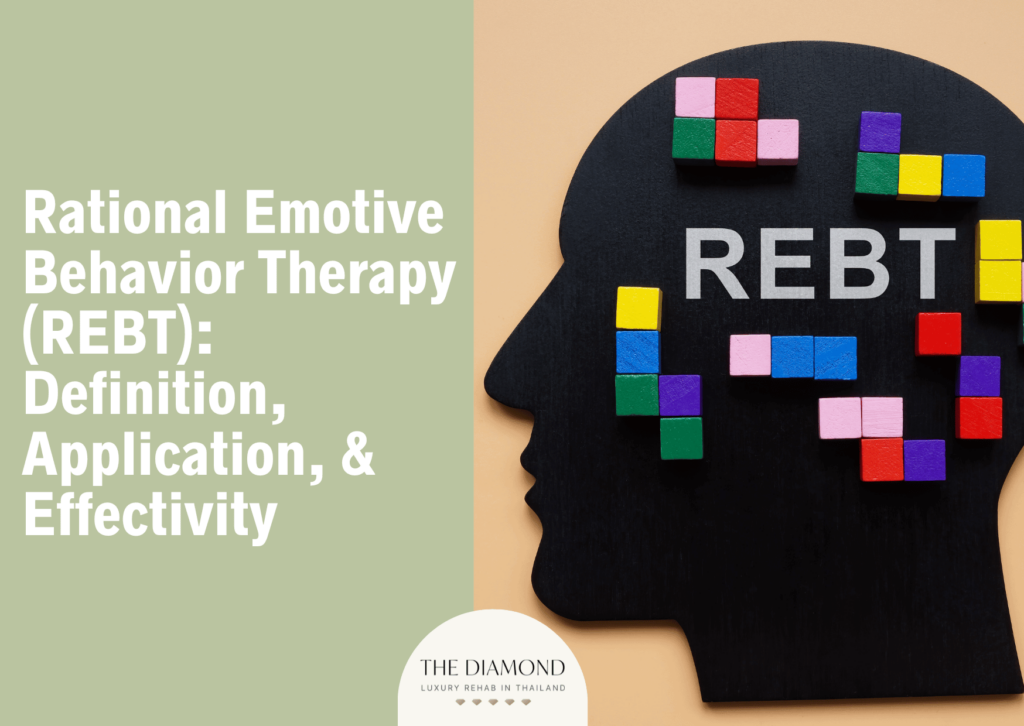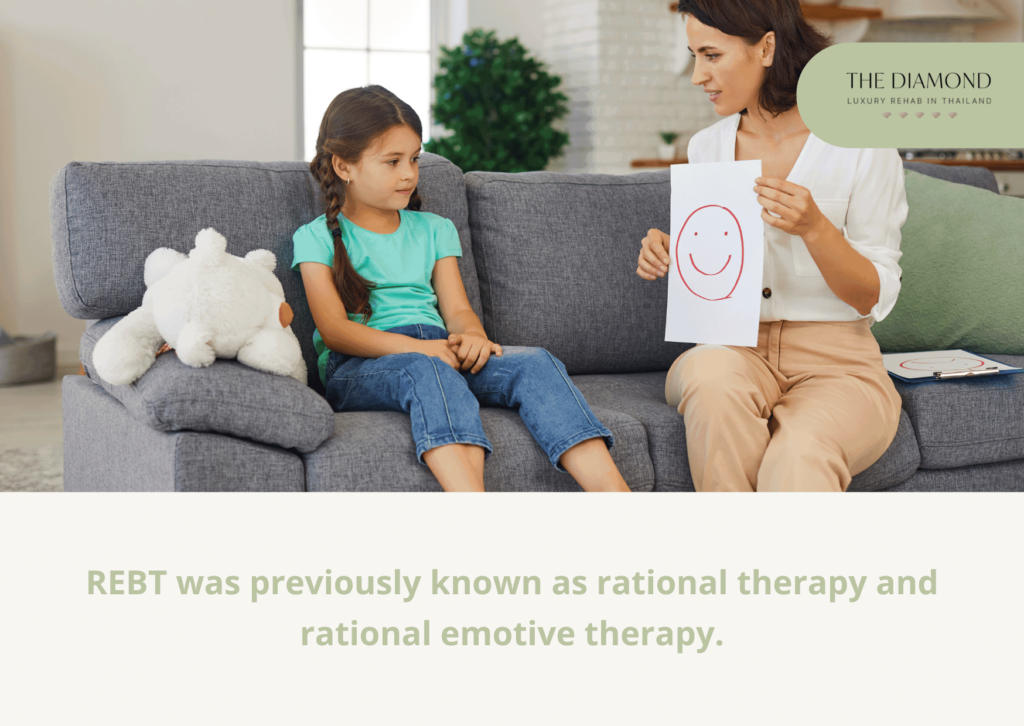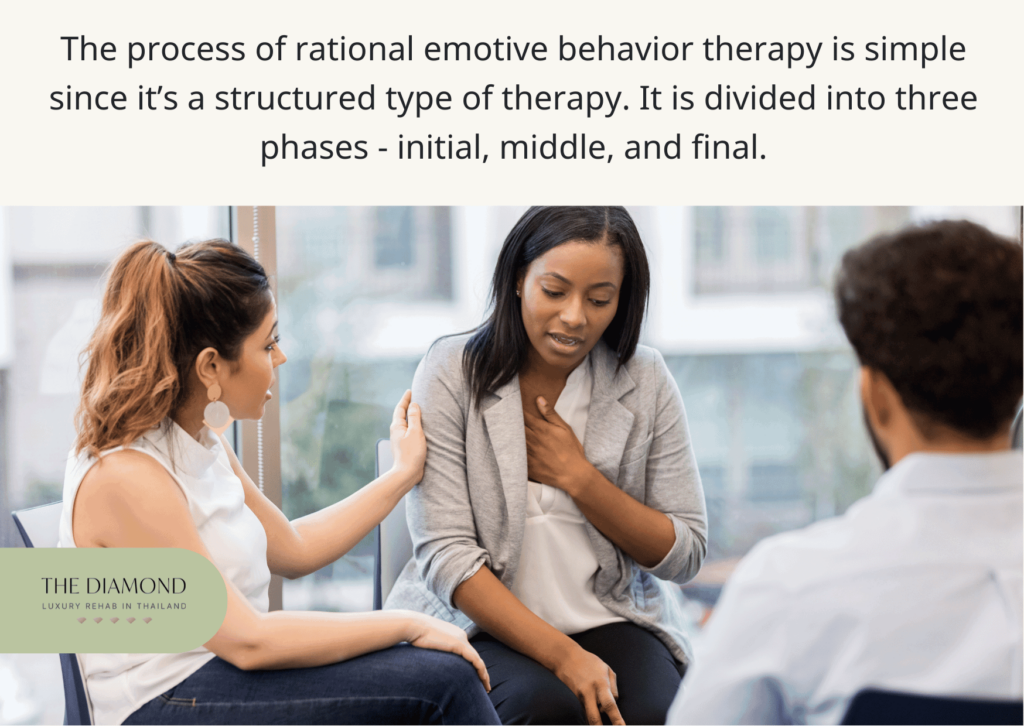Rational emotive behavior therapy (REBT): definition, application, and effectivity
Table of content

Rational emotive behavior therapy (REBT) is a type of psychotherapy that focuses on identifying irrational beliefs in order to change them and thereby positively influence emotions and behavior. It is considered a precursor to cognitive-behavioral therapy.
The main idea in REBT is that persistent and extreme irrational thoughts influence our feelings and behaviors. They lead to mental health problems such as anxiety and depression, as well as risky activities, including addiction.
Through regular sessions, patients learn to identify these beliefs and challenge them so they’re able to modify their thoughts and behaviors.Rational emotive behavior therapy has several applications. Its most common uses include depression, anxiety, addictive behaviors, phobias, overwhelming feelings of anger, procrastination, disordered eating habits, aggression, and sleep problems.
What is Rational emotive behavior therapy (REBT)?
Rational emotive behavior therapy (REBT) is a therapy that focuses on changing irrational and self-defeating thoughts and beliefs to help people learn to manage their emotions. As a pioneering type of cognitive behavioral therapy (CBT), REBT is action-oriented and enables patients to challenge their dysfunctional thoughts to positively influence their behaviors.
REBT was previously known as rational therapy and rational emotive therapy. The importance of REBT stems from the fact that holding or focusing on irrational beliefs about oneself or the world leads to problems. The main objective of rational emotive behavior therapy is to empower patients in identifying and changing those beliefs as well as negative thinking patterns so they’re able to overcome mental distress and psychological problems.
This type of cognitive behavioral therapy teaches us that our behaviors, emotions, and cognition are all connected. The most ideal way to truly understand the influence of situations we encounter in our lives is to take a deep look into our beliefs and emotions attached to them.
The foundation of REBT is the notion that, in general, individuals desire to succeed in life, according to an article titled, “Rational Emotive Behavior Therapy” last updated in September 2018 by Healthline. Everyone wants to be happy and satisfied, but sometimes we meet obstacles created by irrational thoughts and feelings. Irrational beliefs and negative thinking patterns affect how we perceive different events and situations. They make us perceive everything negatively, in most cases.
This form of CBT is based on three core principles, called the ABCs of REBT. Here, A refers to an activating situation that triggers a negative response. Letter B stands for beliefs and irrational thoughts about that situation. And C refers to consequences resulting from those irrational beliefs. In most cases, the consequences are distressing emotions.
After the ABC core principles of rational emotive behavior come the D, E, and F principles. In this case, D refers to dispute i.e. the process of questioning our beliefs and E stands for effective behavior. Effective behavior is the last step, the goal of the therapy where patients create new feelings, which stand for the letter F.

Who created Rational emotive behavior therapy?
American psychotherapist and psychologist Albert Ellis created rational emotive behavior therapy in 1955. In the late 1940s, Dr. Ellis taught at Rutgers University and New York University, but he simultaneously worked in a clinical setting as well. All these places have probably inspired him to create a new approach to psychotherapy. During this time, his faith in psychoanalysis was weak because he considered it ineffective.
However, he realized that when he saw patients once a week or every other week, they achieved the same progress as when he saw them on a daily basis. Dr. Ellis decided to be more active in treating his patients, so he interjected advice or directed interpretations. Patients started improving.
By 1955, Dr. Ellis had given up psychoanalysis. He decided to dedicate his time to changing people’s behavior by enabling them to identify and correct irrational beliefs. A year later, in 1956, Dr. Ellis presented his ideas at a conference organized by the American Psychological Association.
In 1957, Dr. Albert Ellis published the first book about rational emotive behavior therapy. The book was called How to Live with a Neurotic. The same year, he published an article called Rational psychotherapy and individual Psychology. The article is particularly important because that’s where Dr. Ellis set the foundation for rational therapy. He published over 1200 articles and more than 80 books on REBT, marriage, and sex.Dr. Ellis was inspired by various therapists and scientists that came before him. The roots of this therapy are traced to ancient times. More specifically, Stoicism. Good examples of people who influenced Dr. Ellis include Marcus Aurelius, Epictetus, Spinoza, and Bertrand Russell. He started by teaching patients principles that worked for him and helped him overcome his problems. Additionally, the works of Alfred Adler, Harry Stack Sullivan, and Karen Horney influenced Dr. Ellis and his efforts to create an effective type of psychotherapy.
When did Rational emotive behavior therapy become popular?
Rational emotive behavior therapy became popular in the 1960s. At that time, REBT inspired Dr. Aaron Beck at the University of Pennsylvania to develop cognitive-behavioral therapy. In fact, rational emotive behavior therapy is a precursor to CBT.
With increased focus on Dr. Beck’s work, rational emotive behavior therapy, which served as a foundation, additionally received more attention. In the 1990s, Dr. Ellis changed the name of rational therapy to rational emotive behavior therapy mainly because behavioral factors make up a fundamental component of this approach.
A paper by David et al., published in the March 2018 issue of the Journal of Clinical Psychology reported that practitioners and academics have begun to refer to it as rational-emotive and cognitive-behavioral therapy in recent years in order to highlight its contribution to the CBT paradigm. Even today, the popularity of REBT keeps growing, with thousands of professionals practicing it.
Where is Rational emotive behavior therapy used?
Rational emotive behavior therapy is used for the treatment and management of a wide range of mental health problems. The most common uses of REBT are listed below.
- Depression
- Anxiety
- Addictive behaviors
- Phobias
- Overwhelming feelings of anger, guilt, or rage
- Procrastination
- Disordered eating habits
- Aggression
- Sleep problems
1. Depression

Depression is a serious mood disorder that goes beyond feelings of sadness and extends to feelings of helplessness, worthlessness, and severe desperation. A fundamental aspect of the development and progress of depression is irregular thinking patterns i.e., cognitive distortions.
The reality is that everyone experiences cognitive distortions from time to time. The problem occurs when these irrational beliefs become persistent and excessive. They lead to various mental health problems, including depression.
A 2006 study by Taghavi et al., from the journal Perceptual and Motor Skills found that in accordance with Ellis’s theory, depressive patients achieved higher Irrational Beliefs Test scores than the control group.
When left unmanaged, irrational thoughts worsen depression and lead to negative behaviors. That’s where REBT steps in. Rational emotive behavior therapy teaches patients to examine irrational thoughts that exacerbate their depression. Once they identify these cognitive distortions, patients are able to work on changing them with healthier alternatives.
It’s tricky, though, to work on overcoming negative thinking patterns when a person is “locked” in symptoms of depression. However, the therapist uses the most suitable approach to ensure patients make progress from one session to another.
With REBT, patients realize that although we aren’t always aware of our thoughts, they have a major impact on our feelings and behaviors. The good news is that we are able to manage and take control of our thoughts. Doing so alone is tricky and doesn’t work, but with REBT, patients make a difference and learn skills necessary to control their thoughts and, thereby, beliefs and emotions.The duration of REBT therapy for patients with depression depends on the severity of this mental health problem. It takes between one and 18 months.
2. Anxiety

Anxiety, as a mental health disorder marked by intense feelings of fear and worry, is deeply associated with irregular thoughts. The cognitive perspective of anxiety teaches us that certain types of irrational thoughts lead to difficulty coping and the development of symptoms of anxiety.
These irrational thoughts include interpretations of events, appraisals, catastrophic thinking, and other beliefs that aren’t rational. A person experiencing these thoughts is likely not aware of them. It is not entirely clear why these thoughts happen in the first place. A combination of genetic predisposition and environment contributes to the development of cognitive distortions.
The more a person focuses on irrational beliefs, the worse their anxiety becomes. Overcoming these thoughts is easier said than done. It’s impossible to ignore them, but it’s not always possible for a person with anxiety to get better without any help. Rational emotive behavior therapy is a practical approach for patients with anxiety, and numerous therapists use it.
In REBT, anxiety is conceptualized as a negative or unhealthy emotion primarily because it leads to maladaptive functioning. Not only does rational emotive behavior therapy help patients challenge and correct faulty beliefs, it additionally teaches them skills they lack. For example, a person with social anxiety disorder is going to improve social skills throughout the therapy course.The number of sessions for patients with anxiety depends on the type of this mental health problem and its severity. Certain people start feeling better as quickly as three months, but others need four months or longer than that. The duration and success of REBT treatment depend on underlying problems and comorbidities.
3. Addictive behaviors

Addictive behaviors are recurrent actions or activities that people participate in despite the negative consequences, frequently motivated by an intense craving or compulsion. Irrational thinking is one of the most significant components of addictive behaviors.
That happens because cognitive distortions lead to negative emotions and eventually, maladaptive behaviors. They contribute to other mental health problems such as depression and anxiety, both of which significantly increase the risk of addiction. In fact, irrational thoughts jeopardize recovery because if a patient keeps focusing on assumptions, it is likely for them to return to negative and risky behaviors.
Rational emotive behavior therapy helps manage or reduce addictive behaviors by teaching patients to focus on the root cause of the problem. The root cause is the negative or irrational belief. This kind of belief caused a chain of reactions that led to risky behaviors, in this case, addiction.
In order to understand how REBT works here, it’s important to address what is addiction. Addiction is a mental health disorder characterized by a compulsive need or strong urge to use a substance or engage in certain behaviors despite the consequences they cause. A person with addiction tends to believe that they can’t function or something is going to happen unless they take drugs, drink alcohol, or take part in a risky or addictive activity.
By enabling patients to identify cognitive distortions, REBT helps them fix these irrational beliefs through healthier coping techniques and more positive choices. That way, a patient gradually stops considering alcohol, drugs, or addictive behaviors as an escape from their problems.
Therefore, REBT does more than manage addictive behaviors. It helps persons with addiction stop making the same old choices. They are empowered and encouraged to keep healthier ways of handling negative situations. How quickly REBT helps with addictive behaviors depends on the severity of the addiction. Recovery takes three months for certain people, whereas others need six, nine months, or longer.
4. Phobias

Phobias are intense and irrational fears of specific objects, situations, or activities. Individuals with phobias experience excessive anxiety or panic when confronted with the feared stimuli, even if the threat is not objectively significant.
Phobias are strongly linked to irrational beliefs and cognitive distortions. They usually occur due to traumatic events, stress, negative experiences, or through learned behavior. The latter refers to cases when children adopt phobias of their siblings or parents.
Phobia has a major impact on a person’s life and well-being. An individual with a phobia is unable to stop themselves from being scared because they have irrational thoughts.
Rational emotive behavior therapy enables a person to manage their fears by gradually changing their thinking patterns. During REBT sessions, the therapist helps a patient challenge their beliefs. That way, a patient doesn’t simply accept those beliefs as they are.
By challenging their thoughts and beliefs, a patient dissects them, analyzes them, and realizes they are not based on reality. In the management of phobia, REBT works similarly to other types of anxiety. With time, the focus on these thoughts reduces. In turn, a person is able to overcome their phobia or reduce its intensity. How quickly REBT works for overcoming phobia depends on the type of phobia itself. Certain types of phobias are easier to overcome than others. It takes between a few months and a couple of years to achieve full recovery, but patients start noticing improvements sooner than that.
5. Overwhelming feelings of anger, guilt, or rage

Overwhelming feelings of anger, guilt, or rage refer to intense and overpowering emotions that surpass normal levels of emotional response. Anger is a powerful feeling that arises when one feels threatened, unfair, or frustrated and wants to take action or voice their disapproval.
The emotion of guilt is characterized by feelings of shame or remorse after a perceived transgression or defeat. On the flip side, rage is characterized by an out-of-control explosion of anger that frequently comes with irrationality and heightened aggressiveness.
These intense feelings are often tied to anger issues and similar problems. All these emotions are normal, but for certain people, they are difficult to control. As a result, their behavior escalates. Irrational thoughts lead to unhealthy feelings, including depression, anger, or rage.
In several cases, anger and other emotions mentioned above are irrational too. According to Dr. Ellis, common irrational thoughts about anger include the absence of taking responsibility, blaming others, condemning them, self-righteousness, cathartic expression, using anger to control others, egocentric entitlement, and hostile attribution of intent.
Irrational thoughts emphasize feelings of anger, rage, and guilt. This leads to more problematic actions and behaviors. Rational emotive behavior therapy for anger issues helps because in most situations, anger is misplaced and leads to more harm than good. Since REBT works for people with emotional or behavioral problems resulting from irrational beliefs, it is ideal for helping individuals have a more adaptive type of anger.
Everyone gets angry from time to time. What REBT does is that it teaches patients to understand the distinction between rational and irrational anger. In addition, patients learn to process the latter and eventually avoid focusing on it.
For most people, eight to 10 weeks of treatment is necessary to notice significant improvements. How fast the results of REBT occur depends on the intensity of anger issues.
6. Procrastination

Procrastination is defined as the act of delaying or putting off tasks until the last minute or past their deadline. Scientists describe it as a type of failure in self-regulation indicated by the irrational delay of tasks regardless of potential consequences. Procrastinators tend to struggle with irrational thoughts such as fear of success and believing they’re unable to complete the given task.
A 2019 study by Murat Balkis and Erdinç Duru published in the Journal of Rational-Emotive & Cognitive-Behavior Therapy found that both self-doubt and irrational beliefs have a direct and mutually reinforcing impact on the fear of failure. Simultaneously, the fear of failure acts as a mediator in the connection between self-doubt and procrastination. Scientists confirmed that in order to deal with procrastination, future interventions must zero in on changing illogical ideas and strengthening rational ones.
Rational emotive behavior therapy works the same way – enhancing positive and rational thinking patterns while empowering patients to challenge, change, and overcome irrational thoughts.
REBT teaches that people don’t simply procrastinate because they anticipate encountering threats or failure. They procrastinate because they have extreme, rigid, and irrational beliefs about these scenarios. For that reason, the irrational thinking pattern is the target of REBT therapy for procrastination.
A procrastinator gets to identify these beliefs, understand why they are unrealistic, and work on fixing them. Lessing the focus on these beliefs allows them to focus on the task at hand and perform it in a timely manner.How long it takes for REBT to fix procrastination varies from one person to another. It typically takes three to six months to overcome unhealthy habits with positive behavior.
7. Disordered eating habits

The term disordered eating habits refers to preoccupation with food and dieting as well as any other form of abnormal eating pattern. Irrational or distorted thoughts play a major role in the development and progression of eating habits.
Cognitive distortions about appearance, weight, and body image are among the most common types of irrational thinking in people with disordered eating habits. For example, a person has irrational thoughts about their appearance and faulty perception of food, so they starve themselves, hoping to slim down. They develop unhealthy eating habits that put their lives in danger as a result.
Rational emotive behavior therapy helps with disordered eating habits in several ways. The founder of this therapy always emphasized that REBT is designed to help people not just to feel better but to get better as well.
This means that REBT doesn’t just help a person identify irrational thoughts and modify them to feel better. Through this therapy, patients get better by improving their relationship with food. They additionally learn to change their perception of their body and manage body image problems.
REBT helps people develop healthier life philosophy and supports their quality of life beyond recovery. The actual time it takes to get better with REBT depends on the type of eating disorder. For most people, it takes at least four to eight weeks of treatment.
8. Aggression

Aggression is defined as a behavior that intends to harm another person, object, or animal. It can appear as violence or physical aggression, or as emotional aggression. Forceful and hostile behavior toward other people and things tends to stem from irrational thinking patterns. Irrational beliefs lead to dysfunctional attitudes.
These irrational beliefs may vary from one person to another. They usually make it seem like only the other person is responsible for whatever happened. An affected person doesn’t believe they need to take responsibility for something, which is why it’s always something else to blame. They may even feel threatened and react in a violent manner to “protect” themselves or to prove their point.
When these irrational beliefs are left unmanaged, they become worse and so does a person’s behavior. Rational emotive behavior therapy is used to help people with aggression-related issues. They learn to process their emotions in a healthier manner. By learning various skills, they can prevent conflicts. By correcting their irrational thinking patterns, REBT also helps them adopt positive behaviors.
For some people, a few weeks are necessary to overcome aggression, but others may need longer treatment. How quickly REBT helps with this behavior depends on the type of aggression and behaviors attached to it.
9. Sleep problems

Sleep problems comprise a variety of conditions that disrupt the consistent rhythms of sleep. These disturbances have an impact on the length, caliber, or timing of sleep, resulting in challenges with initiating sleep, maintaining sleep, or attaining restorative sleep.
Irrational thoughts are cognitively arousing, keeping a person up and interrupting their sleeping pattern. That being said, irrational beliefs and sleep problems are connected, and their relationship is a two-way street. One influences the other.
For example, results of a 2021 study by Harrington et al., published in the journal Clinical Psychological Science found that participants who were sleep deficient experienced a nearly 50% increase in intrusive thoughts in comparison to those who had a restful night’s sleep.
Since irrational beliefs play a big role in sleep problems, REBT teaches people how to avoid giving these thoughts attention. That way, these thoughts fail to exhibit a cognitively arousing effect that leads to insomnia and other sleep problems. This leads to improved sleep, which, in turn, makes a person more resilient to irrational thoughts.
Rational emotive behavior therapy additionally helps patients adopt habits that promote sound sleep. In other words, it’s not just about pinpointing irrational beliefs and changing them, but improving one’s overall quality of life. Sleep improvement is easier to maintain that way.
Yet another benefit of REBT is that it manages conditions such as depression and anxiety, both of which further contribute to insomnia.Six to eight sessions are necessary for most people to experience the positive influence of REBT on their sleeping patterns. However, every person is different so the duration of the therapy still varies.
What is the process of Rational emotive behavior therapy?

The process of rational emotive behavior therapy is simple since it’s a structured type of therapy. It is divided into three phases – initial, middle, and final.
The first four weeks represent the initial phase when patients usually have two sessions weekly. The first session is introductory. At this point, the therapist sets a clinical diagnosis and performs an assessment as well as general clinical conceptualization.
They focus on building a therapeutic relationship based on empathy, collaboration, and unconditional acceptance of a patient as a person. The therapist, together with the patient, creates a problem list. Sessions two through eight are reserved for tackling each problem from the list based on ABC(DEF) principles mentioned at the beginning of this post.
Weeks five through eight are called the middle phase. Patients have two sessions a week at this stage as well. During this phase, therapists work on strengthening the patients’ rational beliefs and reducing the intensity of irrational thoughts. They encourage and empower patients to understand the links between problems, especially those indicated by common irrational beliefs.
The final phase of REBT occurs during weeks nine through twelve. Patients attend one session per week. The main objective of this phase is to prepare patients for becoming their own therapists. By the end of the treatment, patients must be able to identify irrational thoughts, challenge, and change them on their own. During this phase, therapists additionally discuss dependency problems, relapse prevention, or other aspects of their mental health disorder.
How many sessions are required for REBT?
10 to 20 sessions are required for REBT, generally speaking. Rational emotive behavior therapy is a relatively short-term treatment. In most cases, this number of sessions are necessary to accomplish treatment goals. However, since every patient is different, the number of sessions vary from one person to another, and potentially depend on the treated problem and its severity.
How is Rational emotive behavior therapy done?
Rational emotive behavior therapy is done in individual sessions that usually last around 50 minutes. Occasionally, group therapy is performed, but individual sessions are the core of this treatment.
During therapy sessions, the therapist checks and maintains the therapeutic relationship. Before the main part of the session, the therapist checks the patient’s mood and creates a bridge between the previous and current sessions.
They set the agenda and reviewed homework. The main part of the session accounts for the discussion of the issue on the agenda, followed by setting homework and performing periodic summaries. The session is concluded with a final summary and feedback.
The therapist modifies the approach based on the specific needs of each patient. They are likely to utilize several REBT techniques, including problem-solving, cognitive restructuring, and coping.
Problem-solving techniques address the activating event (principle A). The main objectives of these techniques are to improve assertiveness, decision-making, problem-solving, conflict resolution, and social skills.
On the other hand, cognitive restructuring focuses on changing irrational beliefs (principle B). Various approaches serve this purpose, including disputing irrational thoughts, logical or rationalizing techniques, exposure to a feared situation, humor and/or irony, and reframing or observing the events in a different manner.
Coping REBT therapy techniques are concerned with the consequences of irrational thoughts (principle C). Therapists recommend coping techniques such as relaxation, meditation, and hypnosis.
An important aspect of REBT, regardless of the technique, is homework. The main purpose of homework is to allow a patient to apply the skills they learned during therapy sessions to their daily life. It’s good to write down those situations, skills applied, and what happened after or how you felt.
Who performs rational emotive behavior therapy?
Rational emotive behavior therapy is performed by a licensed and certified rational emotive behavior therapist. In order to perform REBT, it is necessary to attend core training and meet the criteria necessary for qualification. Qualified therapists additionally have to renew their license every two years, submit videos of them practicing REBT, and meet criteria that testify about their readiness to provide proper treatment to their patients.
What does a rational emotive behavior therapist do?

A rational emotive behavior therapist uses REBT to treat people with various mental health problems using established principles. Generally speaking, the REBT therapist acts as a guide toward helping patients understand their thoughts, feelings, and condition so they’re able to improve their mental health and well-being.
The role or job description of an REBT therapist is to assess patients, determine the number of sessions necessary, and structure them properly. They need to choose adequate techniques and give homework to patients as well.
Qualities of an REBT therapist include patience, emotional stability, empathy, strong communication skills (oral and written), advanced analytical skills, listening and interpersonal skills, problem-solving skills, and creativity.At the same time, an REBT therapist fully respects a patient and understands their problem, allowing them to talk about irrational beliefs without judging them. Not only is an REBT therapist an excellent listener, but optimistic, trustworthy, and open-minded too.
Is Rational emotive behavior therapy effective?
Rational emotive behavior therapy is, indeed, effective in the treatment and management of various mental health problems. A growing body of evidence confirms the effectiveness of this therapy.
A good example is a 2020 study by Jiwon Yang and Kuem Sun Han published in the Journal of Eating Disorders which found that the binge eating behavior management program based on REBT improved the participants’ self-esteem by lowering their levels of depression, anxiety, and covert narcissism as well as body dissatisfaction and binge eating. Scientists concluded REBT intervention could help to improve the health and general well-being of female college students.
A review of 84 published articles on REBT by David et al., published in the Journal of Clinical Psychology in 2018 confirmed that rational-emotive behavior therapy is a sound psychological intervention. It was found to be helpful for persons with depression, social anxiety, obsessive-compulsive disorder, and disruptive behavior.
Furthermore, the April 2021 issue of Military Psychology published a study by Grove et al., that found that rational emotive behavior therapy was effective for veterans with PTSD. In the study, those with comorbid PTSD and depression or anxiety experienced significant symptom reductions after five weeks of group therapy.
To add to that, the American Journal of Psychotherapy published a study by David et al., in its December 2021 issue, which found that following REBT, patients reported substantial improvements in their level of functioning.
Using this approach further proved to be effective in lowering the stress, feelings of burnout, and dysfunctional distress that were present in special education instructors, as per a study by Onuigbo et al., published in the June 2020 issue of the World Journal of Clinical Cases.
As seen above, rational emotive behavior therapy is considered effective for the management of different mental health problems ranging from eating disorders to stress.

